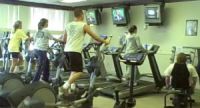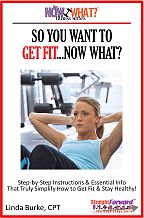Buy "The Now What? eBooks" Here! Or go to Smashwords for misc. formats.
The Now What Fitness Series lays out the foundation of fitness in a concise and simplified manner, making for a collection of books that help the reader truly comprehend how to improve one's health and well-being from A to Z. I've broken fitness down into comprehensive concepts, giving anybody who truly wants to change their health and their lives in profound ways, the step-by-step tools and knowledge to do so.
ACSM CARDIO GUIDELINES
The American College of Sports Medicine (ACSM) has instituted a list of cardiovascular fitness guidelines, which I have listed for you below.

- The 3 basic components to any exercise conditioning session
are warm-up, conditioning stimulus, & cool-down.
- Warm-up & cool-down performed at approximately 50% of stimulus intensity (hold conversation without much difficulty).
- Warm-up & cool-down may take 5-15 minutes, depending on
age & fitness level.
- Accumulate moderate-intensity exercise (40-60% of HRR) for
at least 30 minutes on 5 or more days a week, for a total of 150 minutes per
week, or vigorous-intensity exercise (60-85% of HRR) for at least 20-25 minutes
on 3 or more days a week for a total of 75 minutes per week. For weight loss,
50-60 minutes per day to a total of 300 minutes moderate exercise is
recommended. (Intermittent activities in 10-minute increments have same health
benefits as continuous activities.) *See "Intensity" below
for explanation of HRR.
- Frequency: At least 3-5 days a week.
- Intensity: 40-60% of (HRR) heart rate reserve is considered moderate intensity and 60-85% heart rate reserve is considered vigorous. Very deconditioned individuals may begin to improve at about 30-40% of HRR. To figure your estimated HRR use this equation: 220 – age - resting heart rate x .60 to .85 + resting heart rate. For more on that check out the Target Heart Rate page.
- Duration: 20-60 or more minutes per session, continuous or intermittent activity. If you are very de-conditioned you may even need to split it up into several 10-minute segments. Like Nike says, JUST DO IT! Increase your duration by 5 minutes a week until you reach your desired amount.
- Type: Aerobic (run, brisk walk, swim, cross-country ski, dance, elliptical trainer, cycling, stationary bike, etc.)
- The 3 stages of cardiorespiratory training: Initial, Improvement, Maintenance.
- Progression of both intensity and duration in a single session is not recommended. Increase the duration first before increasing the intensity. If you can complete an exercise session at the upper level of frequency and duration for 2 weeks without signs of excessive fatigue, progress to the next level.
- If training is discontinued, gains in fitness regress by approximately 50% within 4-12 weeks.
- If weight loss is your goal, frequent, enjoyable exercise periods of low to moderate intensity and relatively long duration result in the largest weekly caloric expenditures.
- Stay within your heart rate range. Monitor through a heart rate monitor or manually at carotid artery on neck or radial artery on thumb side of wrist.
LET'S GET THIS PARTY STARTED!
If you're ready to begin your aerobic training, click here to learn how to get started. There's no time like the present. However, be sure and check with your doctor before starting any new exercise program.
_________________________________________________________________________________________
DON'T FORGET TO SIGN UP IN THE FORM TO THE UPPER RIGHT FOR YOUR FREE MONTHLY NEWSLETTER, THE STRAIGHTFORWARD FITNESS FLASH!!
Plus, just for signing up you'll receive a copy of my eBook, The Gym Equipment Handbook. By learning how to use the equipment in your gym properly you'll get better results in half the time! Please be sure and contact me if you have any problems with the download of your eBook. Thanks for stopping by and ENJOY!
Return from ACSM Cardio Guidelines to Cardiovascular Fitness
Return from ACSM Cardio Guidelines to Straightforward Home
